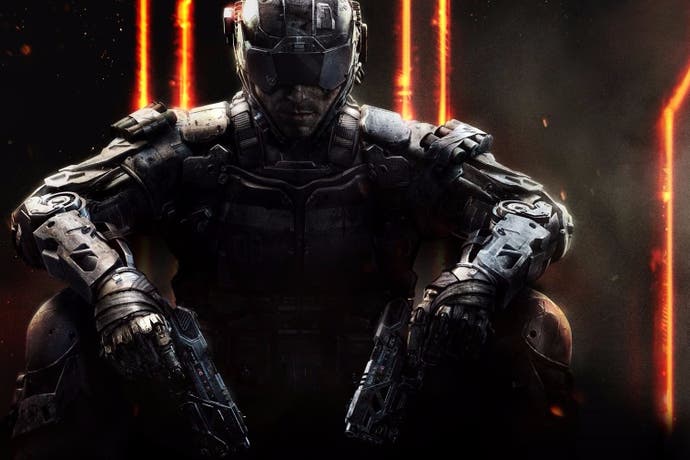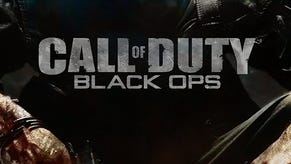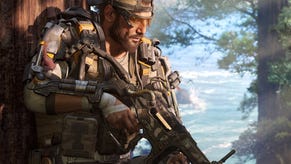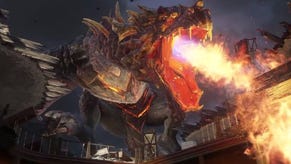Call of Duty: Black Ops 3 review
Another tale of two Duties.
A day will dawn when the muscularity and variety of Call of Duty's multiplayer component aren't enough to compensate for the muddled single-player - when the euphoria of a cross-map Tomahawk kill fails to outweigh the leaden writing, the hand-holding and the tedious inevitability of an on-rails vehicle sequence. That day isn't today, but perhaps it isn't far off.
While ostensibly a question of hardware, Activision's decision to chop the campaign from the Xbox 360 and PS3 versions of Black Ops 3 sends a fairly unambiguous signal about which parts of the package it considers worth the asking price. The story itself - a fretful piece of fourth-wall performance theatre that riffs on ethical and existential anxieties raised by the advent of military bio-augmentation - suggests a developer casting around for a sense of purpose. It alludes to the franchise's ongoing design hang-ups so frequently and explicitly that this is as much a cry for help as a battlecry. The new cybernetic abilities at least add nuance to larger firefights, and are the basis for some barmy, extremely self-aware level design. But at the end of the day, Black Ops 3's campaign embraces more of Call of Duty's old shortcomings than it casts aside.
The restoration of four-player co-op - a much-touted feature - underlines all this. There are moments when the size of the environments and spread of auxiliary powers accommodate real teamwork - one player hanging back to remote-possess a trundling caterpillar mech, while another deploys nanobots to lock down infantry so that the remaining two players can wall-run into their midst, brandishing SMGs. But ultimately, the effect of having more players around is to make environments feel smaller, the rigid gating mechanisms all the more aggravating (there's the odd invisible barrier, even, while an NPC finishes uttering some forgettable line of dialogue). And climatic battles too often default to chipping away at a juggernaut with a ridiculous health bar, rather than inviting you to make clever use of all the superhuman abilities at your disposal.
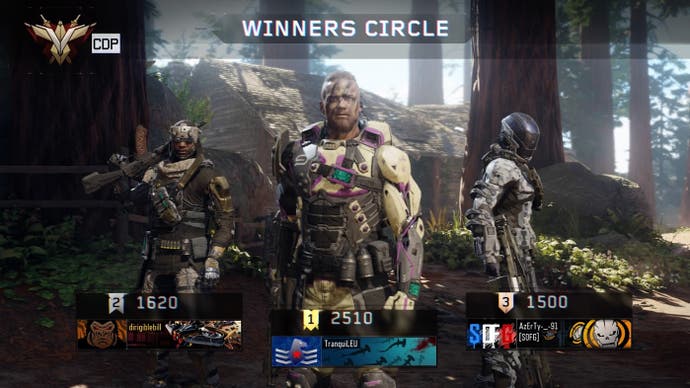
Predictably, the competitive multiplayer has adapted to changing times and tastes much more gracefully. Among its headline new features are the Specialists, nine multiplayer avatars who comprise a sort of cyberpunk Expendables. They are, in truth, nothing more profound than nine pairs of unlockable timed-use abilities, which charge up passively in the course of a battle, like Titanfall's Titans (also as in Titanfall, you can accelerate their arrival by piling up the bodies). They're presented, however, as fully functioning characters with bespoke animated menu screens, backstories, grating pre-match banter and medals.
The idea, I think, isn't so much to change how the multiplayer works as to give it a human, or at least cyborg, face that might allow it to exist independently of an actual narrative - to acquire for Call of Duty's PvP component an ensemble charm comparable to that of a MOBA, with 'big names' a Twitch audience can rally behind, rather than generic classes or load-outs. Continuing with that parallel, the presence of an Arena playlist with the option to vote on which Specialists, perks, guns and gear make the cut is an obvious homage to the meta-games of DOTA and League of Legends. It suits a well-organised team, but a casual player might want to dip in simply for the baptism of fire that is having all your favourite assault rifles banished from play.
That's not to say that Specialists have an entirely cosmetic impact. The special abilities themselves aren't much more outrageous than the returning perks and streak rewards - they include holographic decoys, speed buffs, a cluster grenade launcher, a self-revive, explosive-tipped arrows and an incredibly satisfying chain-lightning gun. But the changeable interval before they're available and the fact that they're associated with a specific character model add a compelling layer of speculation and risk.
If, for instance, we're a few minutes into a round of Domination and two opposing players have picked Nomad (a sort of affable lumberjack), I can be reasonably sure that every objective will be home to a lethal little barnacle of nanobots, waiting to erupt under my heels. If I'm jogging down a hallway and James Hetfield-alike Ruin is coming the other way at a gallop, like a soggy golden retriever zeroing-in on the family picnic, there's a fair chance he has a ground-pound banked and ready to fly. The other player might notice in turn that I'm playing as ninja quarterback Tempest, and ponder the odds of my using the Glitch ability to teleport out of trouble (assuming I don't just shotgun the blaggard while he's going through the wind-up animation). There are too many variables in play to be absolutely confident about any of this - and that uncertainty is, of course, part of the fun.

Treyarch's handling of wall-runs also feels like an effort to reposition Call of Duty in today's market, rather than fundamental change, but the way the studio mixes these ingredients with the franchise's staple diet of corner-kills and quickdraw is, at times, inspired. The wall-run is more of an option than a necessity - heavier-footed and more stamina-intensive than Titanfall's pioneering scramble, and a trick that leaves you at greater risk given Call of Duty's higher concentrations of players. There are sections where the developer has failed to elegantly reconcile Call of Duty's traditional approach to map-making with Black Ops 3's acrobatic range: rooftops that rebuff your advances because it would wreck the balancing, and the odd building facade that doesn't take kindly to being used as a floor.
But these are infrequent disappointments, and the satisfaction of uncovering a route that transports you to the other team's spawn in a heartbeat - holding down jump to boost away from, then back around corners, or tapping it to fly between the walls of a passage - is meatier for being wrestled from claustrophobic, crowded environments. The launch maps are pretty down-to-earth on the face of it: most are built around two or three lanes, with that timeless Call of Duty alternation of open courtyards, overlooks, claustrophobic stairwells and low cover, plus the occasional underwater shortcut. The more you play, however, the more deviously you'll make use of the vertical axis.
On Redwood, for instance, it's possible to scamper around treetrunks in order to switch from one cliff-face to the next without touching down, pruning a flanking manoeuvre by a fraction of a second. Scurrying along the side of a stairwell on Combine might allow you to drop directly behind an attacker, or at least carry you away from a grenade. And then there are those glorious moments when you meet another player wall-running in the opposite direction, and engage in a frantic anti-gravity jousting tourney. Players can aim down the sights while wall-running, but I've found the splashy rapid-firing Haymaker shotgun is your best friend in these situations.
Advanced Warfare's boost-jump and dodging divided players, and Black Ops 3's variation will see its fair share of love and hate. Treyarch has slowed the pace a little: you can no longer air-dash or boost-dodge in any direction, which makes duelling less twitchy and nudges the action back towards the original Modern Warfare. This is offset by the ability to extend a boost-jump by holding the button, a tweak that helps you chain together wall-runs.
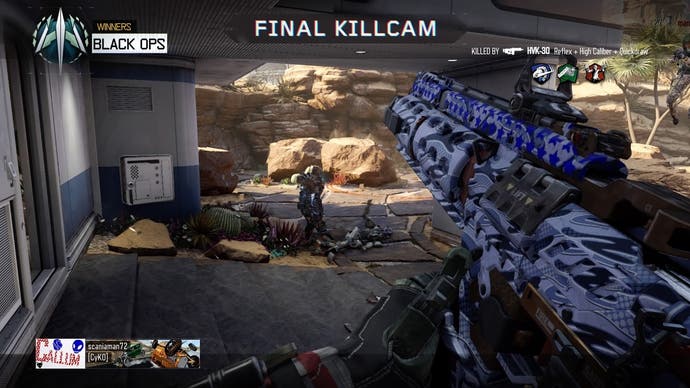
I really like the new system's heftiness - you can almost feel your organs sinking back into your accelerating body when you boost - but as with Advanced Warfare, it can be frustrating when an opponent escapes death by dint of a wild, clumsy leap. It's perfectly possible to counteract this with practice, however. The rockstar knee-slide also has potential to annoy, but I think that's mainly because it looks so ostentatious, rather than because it ruins the gunplay: the move requires a full boost bar, so using it means sacrificing your ability to evade. All told, Black Ops 3's movement abilities are a smart adjustment of a system that has attracted fierce criticism, but also plenty of adulation.
There are no cybernetic abilities in the latest incarnation of Zombies, Treyarch's beloved four-player celebrity survival mode (those who want to pit their million-dollar implants against hordes of the undead should make a beeline for Nightmares, the remixed "second" campaign that unlocks after the credits). You get something almost as good, however: the ability to transform very briefly into a hyperactive octopus at mystical fonts. The "Beast", as it's known to friends, is one part Cthulhu to one part Bionic Commando, armed with a grappling tentacle plus electricity attacks that can be used to kickstart power generators. This pays into a more complex take on the well-worn process of unlocking doors, resource dispensers and guns with cash from kills while searching for the exit.
It's enjoyably mysterious, after the adrenaline peaks of competitive multiplayer. You need to not only find but also place certain objects to make progress, and the threats range from garden-variety shamblers to demon bugs, wraiths and rotting hulks with multiple heads. Care must be taken when assigning Beast duties, as transforming means losing out on the opportunity to make money, which might doom a player in the long run. I think I prefer the mobility of Advanced Warfare's version all the same, but then again Advanced Warfare didn't have Jeff Goldblum posing as a crap magician, and the sleazy vaudeville setting is a joy.
If only the new campaign were as rewarding and assured as what surrounds it. Black Ops 3 is the kind of Jekyl and Hyde experience that makes you wonder whether Quantum Break's blend of live-action episodes and gameplay should be more widely applied - perhaps the solution to Call of Duty's inner conflict is to admit defeat and turn the single player into an action movie, while piling development resources back into the multiplayer.
The immediate objection there is that, going by the average Call of Duty cutscene, the movie would be an absolute stinker. And besides, the flashes of verve in Zombies and during the Black Ops 3 campaign's more deranged, self-referential chapters suggest that an unreservedly marvellous Call of Duty solo experience is out there. Let's hope the multiplayer can hold our attention long enough for a developer to find it.
